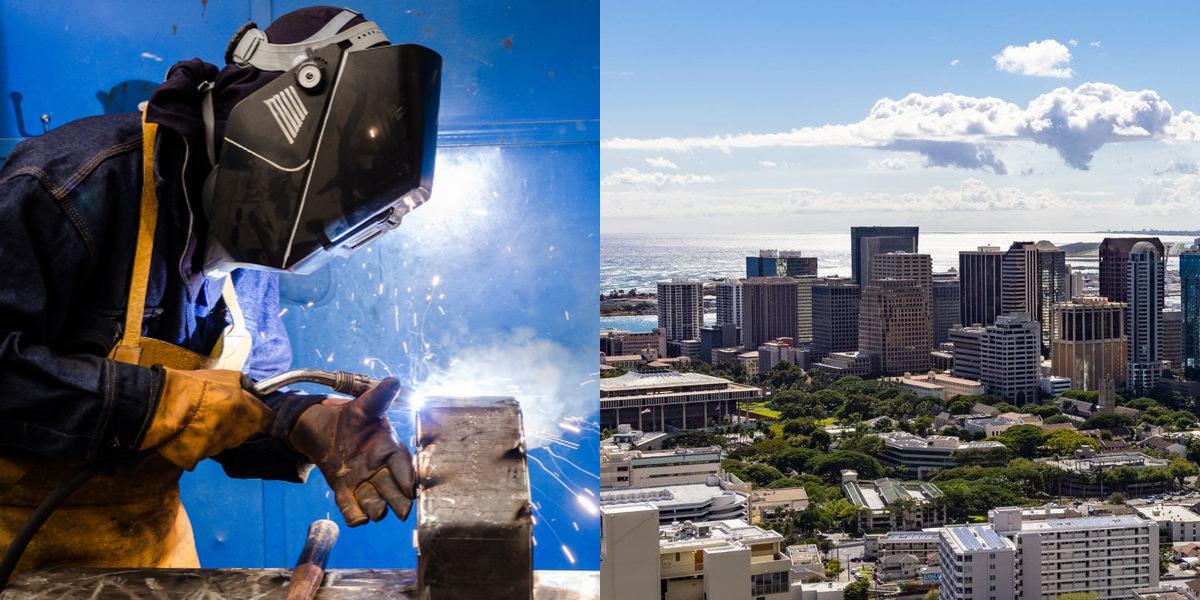How to Become a Welder in Hawaii

Welding is a skilled trade that involves joining metal parts together using heat and pressure. Welders play a crucial role in various industries, including construction, manufacturing, and automotive. If you have an interest in working with metal and want to pursue a career in welding, here's what you need to know about becoming a welder in Hawaii.
How do I get my Welder certification?
If you are interested in becoming a welder, one of the first steps you should take is to obtain your welder certification. This certification is a crucial credential that demonstrates your skills and knowledge in the field of welding.
To get your welder certification, you will need to complete a training program and pass a certification exam. Here are the steps you can take to obtain your welder certification:
-
Research the requirements: The first step is to research the requirements for welder certification in your area. Different states and countries may have different requirements, so it is important to know what is expected of you. You can check with local trade schools, vocational schools, or welding organizations to find out more information about the specific requirements in your area.
-
Enroll in a welding training program: Once you have an understanding of the requirements, you can enroll in a welding training program. These programs are typically offered by trade schools, vocational schools, or community colleges. They provide hands-on training and classroom instruction in various welding techniques and safety procedures. It is important to choose a program that is accredited and recognized by industry organizations.
-
Gain practical experience: In addition to completing a training program, it is important to gain practical experience in welding. Many training programs include an apprenticeship or internship component, which allows you to work under the supervision of an experienced welder. This hands-on experience is invaluable in developing your skills and preparing you for the certification exam.
-
Prepare for the certification exam: Once you have completed your training program and gained practical experience, it is time to prepare for the certification exam. The exam will test your knowledge and skills in various welding techniques, safety procedures, and industry standards. There are several resources available to help you prepare for the exam, including study guides, practice exams, and online tutorials. It is important to dedicate time and effort to study and practice before taking the exam.
-
Take the certification exam: After you have prepared for the exam, you can schedule a date to take the certification exam. The exam will typically consist of both written and practical components. The written portion will test your knowledge of welding theory and industry standards, while the practical portion will assess your ability to perform various welding techniques. It is important to stay calm and focused during the exam and to follow all safety procedures.
-
Receive your certification: Once you have successfully passed the certification exam, you will receive your welder certification. This certification is a valuable credential that demonstrates your skills and knowledge in welding. It can open up many doors for career opportunities and advancement in the field.
How do I get a job as a Welder?
Once you have obtained your welder certification, you are ready to start looking for a job as a welder. Here are some steps you can take to increase your chances of finding employment as a welder:
-
Build a strong resume: Your resume is your first opportunity to impress potential employers. Make sure to highlight your welder certification, as well as any relevant work experience or training you have. Include specific details about the types of welding techniques you are proficient in and any specialized equipment you have experience with. It is also important to include any certifications or licenses you have obtained.
-
Create a portfolio: In addition to a strong resume, it is helpful to create a portfolio of your work. This can include photographs or videos of projects you have completed, as well as any certifications or awards you have received. A portfolio can give potential employers a visual representation of your skills and help you stand out from other applicants.
-
Network within the industry: Networking is a valuable tool in finding job opportunities in any field, including welding. Attend industry conferences, trade shows, and workshops to meet other professionals in the field. Join professional organizations or associations for welders to connect with others and stay informed about job opportunities. You can also reach out to local welding companies or contractors to inquire about job openings or apprenticeship opportunities.
-
Apply for jobs: Once you have built a strong resume, created a portfolio, and networked within the industry, it is time to start applying for jobs. Look for job postings online, in local newspapers, or on job boards specific to the welding industry. Tailor your resume and cover letter to each job application, highlighting the skills and experience that are most relevant to the position. Follow up on your applications with a phone call or email to express your continued interest in the position.
-
Prepare for interviews: If your application is successful, you will be invited for an interview. It is important to prepare for the interview by researching the company, reviewing common interview questions, and practicing your responses. Dress professionally and arrive on time for the interview. During the interview, be confident and articulate, and be sure to highlight your skills, experience, and certifications.
-
Continue learning and growing: Once you have secured a job as a welder, it is important to continue learning and growing in your field. Attend workshops or training programs to stay updated on the latest welding techniques and industry standards. Seek opportunities for professional development and advancement within your company. Regularly evaluate your skills and set goals for improvement.
Career Paths and Opportunities after Becoming a Welder
Becoming a welder can open up a wide range of career paths and opportunities. Here are some of the potential career paths you can pursue after becoming a welder:
-
Welding Inspector: As a welding inspector, you would be responsible for ensuring that welding projects meet industry standards and quality requirements. This role requires a deep understanding of welding techniques, materials, and safety procedures. Welding inspectors often work for construction companies, manufacturing companies, or government agencies.
-
Welding Engineer: Welding engineers are responsible for designing and developing welding processes and procedures. They work closely with other engineers and designers to ensure that welding projects are efficient, cost-effective, and meet quality standards. This role requires a strong knowledge of welding techniques, materials, and industry standards.
-
Welding Supervisor: Welding supervisors oversee a team of welders and ensure that welding projects are completed on time and according to specifications. They are responsible for managing resources, scheduling work, and ensuring compliance with safety procedures. This role requires strong leadership and communication skills, as well as technical knowledge of welding processes.
-
Pipe Welder: Pipe welders specialize in welding pipes and tubing used in various industries, such as oil and gas, plumbing, and construction. They work with different types of materials, such as steel, stainless steel, and aluminum, and use specialized techniques to ensure strong and durable welds. Pipe welding requires precision and attention to detail.
-
Structural Welder: Structural welders work on projects involving the construction of buildings, bridges, and other structures. They are responsible for welding together the framework and supports that form the structure. This type of welding requires strength and physical stamina, as well as the ability to read and interpret blueprints and welding symbols.
-
Underwater Welder: Underwater welding is a specialized field that involves welding in underwater environments, such as offshore oil rigs or underwater structures. This type of welding requires additional training and certification, as well as specialized equipment. Underwater welders must be comfortable working in confined spaces and in potentially hazardous conditions.
These are just a few examples of the many career paths and opportunities available to welders. The field of welding is diverse and offers a wide range of options for specialization and advancement. With the right skills, certifications, and experience, you can build a successful and fulfilling career as a welder.
How much does a Welder make?
The average salary for a welder can vary depending on factors such as experience, location, and industry. According to the U.S. Bureau of Labor Statistics (BLS), the median annual wage for welders, cutters, solderers, and brazers was $43,410 as of May 2020. The lowest 10 percent earned less than $30,860, while the highest 10 percent earned more than $64,240.
Starting salaries for welders can vary greatly. Entry-level welders with little to no experience may start at or near the lower end of the salary range. However, as they gain experience and develop their skills, their earning potential increases.
Final Thoughts
Becoming a welder can be a rewarding and fulfilling career choice. It offers opportunities for creativity, problem-solving, and hands-on work. Whether you choose to work in construction, manufacturing, or another industry, welding skills are in high demand.
To get started on your journey to becoming a welder, research the requirements for certification in your area and enroll in a reputable training program. Gain practical experience and prepare for the certification exam. Once you have obtained your certification, build a strong resume, create a portfolio, and network within the industry to increase your chances of finding employment.
Once you have secured a job as a welder, continue learning and growing in your field. Consider pursuing additional certifications or advanced training to expand your skills and open up new career opportunities. With dedication, hard work, and a passion for welding, you can build a successful and fulfilling career as a welder.
Are you thinking about a job change or wanting to learn more about different career paths? Feel free to check out these additional articles:

Vduani Martinez is a part of the Growth team at Dreambound. She creates and fixes workflows and automation to guarantee seamless operations. On top of that, she manages databases to ensure all information is up to date. Vduani is a licensed Electronics Engineer who loves coffee and is a travel enthusiast. Out of the office, she enjoys going on road trips and discovering new cafes and restaurants.



